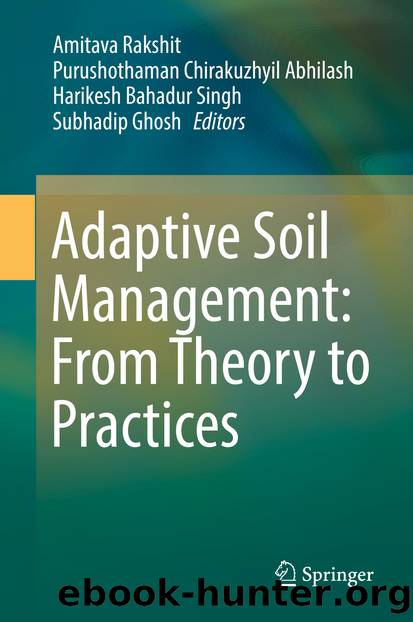Adaptive Soil Management : From Theory to Practices by Amitava Rakshit Purushothaman Chirakuzhyil Abhilash Harikesh Bahadur Singh & Subhadip Ghosh

Author:Amitava Rakshit, Purushothaman Chirakuzhyil Abhilash, Harikesh Bahadur Singh & Subhadip Ghosh
Language: eng
Format: epub
Publisher: Springer Singapore, Singapore
14.5 Microbial Integrity for Plant Fitness Under Acid Stressed Soil
Soil acidity is a global problem in crop production. About 40% cultivated land is greatly affected by soil acidity. Despite ample N, P, K supplementation in soil, crop productivity in acid soils is still below average. This is due to ionic toxicity, particularly Al toxicity which is a yield-limiting factor in acid soil (Marschner 1991). Availability of phosphorus is also restricted due to formation of relatively insoluble Al and Fe phosphate in acidic soil.
Acid soil is not at all problem soil. Rather it is the nature of soil as those of other soil types. Reclamation of acidic soil with the application lime stone is conventional mitigation option. But it is not a permanent solution. It recurres within year or two, thus, involves a recurring cost—unaffordable to poor farmers of universally inhabitant of acidic locality in the globe. Moreover, lime induced CO2 production as a source of greenhouse gas is claimed by the environmentalists. Under this context, adaptive soil management that will help the crop plant to acclimatize in existing system without hampering the current environmental health. Encroaching deep soil by selecting deep rooted crop plants, root-induced changes in rhizosphere such as pH increase, release of chelator like amino acids, organic acids for aluminium and augmentation of autochthonous acidophilic beneficial microorganisms, particularly mycorrhizae for increased root surface are the possible adaptive management options for acid soil.
Fungi by acidophilic in nature can improve the plant fitness to an acid soil. Especially mycorrhizal association with crop plants in acidic soil evolves adaptive mechanisms to improve plant fitness in acidic soils having low plant available phosphorus (Marschner 1995; Dodd 2000). Plant-mycorrhizal symbiotic association enhances plant ability to exploit more soil nutrient, particularly, phosphorus and zinc by virtue of extended root surface due to fungal mycelial envelop on plant root (Dodd 2000; Marschner 1998). It is interesting to note that the length of mycorrhizal fungal thread in each centimeter of root may be in the range of 10–100 m in P-deficient soils (McGonigle and Miller 1999). Benefits derived from plant-fungal association are more conspicuous in soil generally poor in nutrients. 70–80% more phosphorus; 50 and 60% more Zn and Cu uptake were recorded in a pot experiment with mycorrhizal inoculated white clover (Li et al. 1991).
Mycorrhizal colonization of plants enhances their ability to explore the soil for P through the action of the fungal mycelium. This results in increased exploration of the soil for available nutrients and delivers more mineral nutrients, particularly P, to plant roots (Dodd 2000; Marschner 1998). It is estimated that the extent of fungal mycelium may be in the range of 10–100 m per cm root or per gram of soil under field conditions in P-poor soils (McGonigle and Miller 1999). In general, the contribution of mycorrhizal associations to the plant nutrient supply is larger in soils with poor availability of mineral nutrients than in soils rich in nutrients. In pot experiments, mycorrhizal colonization contributed to the total P uptake with between
Download
This site does not store any files on its server. We only index and link to content provided by other sites. Please contact the content providers to delete copyright contents if any and email us, we'll remove relevant links or contents immediately.
| Automotive | Engineering |
| Transportation |
Whiskies Galore by Ian Buxton(41530)
Introduction to Aircraft Design (Cambridge Aerospace Series) by John P. Fielding(32889)
Small Unmanned Fixed-wing Aircraft Design by Andrew J. Keane Andras Sobester James P. Scanlan & András Sóbester & James P. Scanlan(32573)
Craft Beer for the Homebrewer by Michael Agnew(17933)
Turbulence by E. J. Noyes(7700)
The Complete Stick Figure Physics Tutorials by Allen Sarah(7141)
Kaplan MCAT General Chemistry Review by Kaplan(6595)
The Thirst by Nesbo Jo(6437)
Bad Blood by John Carreyrou(6276)
Modelling of Convective Heat and Mass Transfer in Rotating Flows by Igor V. Shevchuk(6223)
Learning SQL by Alan Beaulieu(6035)
Weapons of Math Destruction by Cathy O'Neil(5829)
Man-made Catastrophes and Risk Information Concealment by Dmitry Chernov & Didier Sornette(5649)
Digital Minimalism by Cal Newport;(5389)
Life 3.0: Being Human in the Age of Artificial Intelligence by Tegmark Max(5184)
iGen by Jean M. Twenge(5162)
Secrets of Antigravity Propulsion: Tesla, UFOs, and Classified Aerospace Technology by Ph.D. Paul A. Laviolette(4992)
Design of Trajectory Optimization Approach for Space Maneuver Vehicle Skip Entry Problems by Runqi Chai & Al Savvaris & Antonios Tsourdos & Senchun Chai(4840)
Electronic Devices & Circuits by Jacob Millman & Christos C. Halkias(4748)
